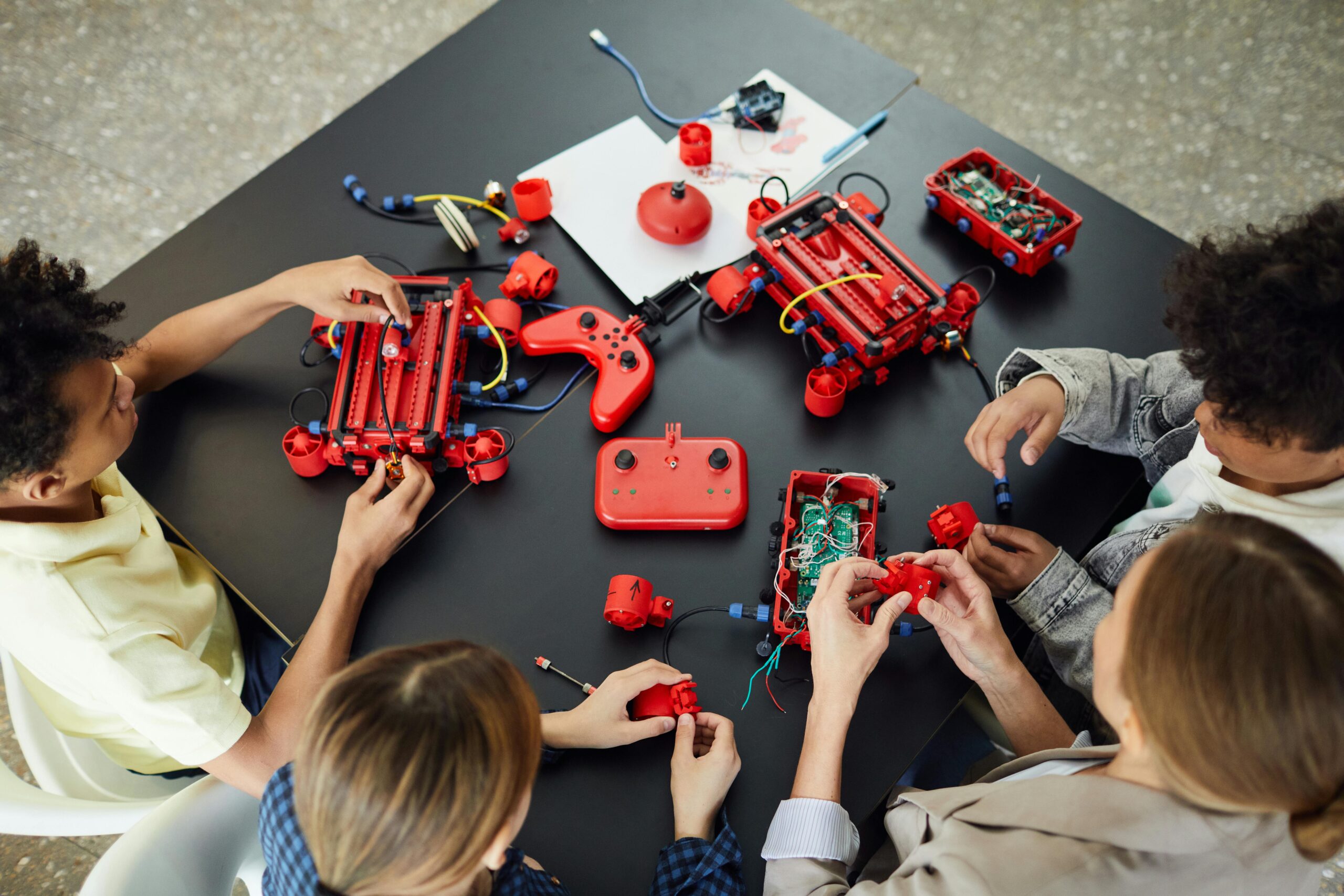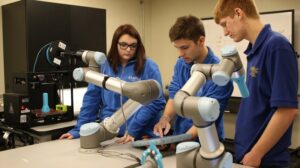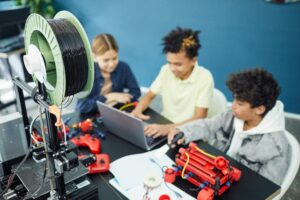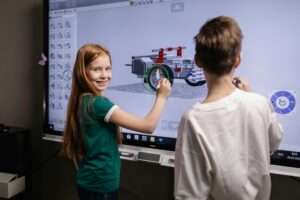Robotics Learning: Shaping the Future of Education and Innovation
Introduction
Robotics is no longer confined to science fiction or high-tech laboratories—it has become an essential part of modern education, industry, and everyday life. From autonomous vehicles to robotic surgery, the applications of robotics are transforming how humans live and work. With this growing influence, robotics learning has emerged as a vital skill set for students, engineers, entrepreneurs, and even hobbyists.
Robotics learning combines mechanical engineering, electronics, programming, and artificial intelligence (AI) into one multidisciplinary field. By engaging with robotics, learners not only acquire technical skills but also develop problem-solving abilities, creativity, and teamwork. This article explores the meaning of robotics learning, its importance, methods, tools, challenges, and the future it promises.
What is Robotics Learning?
Robotics learning refers to the process of understanding, designing, programming, and applying robots for specific tasks. It involves:
-
Mechanical Design – Learning how robots are built, including their frames, joints, and actuators.
-
Electronics and Sensors – Understanding circuits, microcontrollers, and sensors that help robots interact with the environment.
-
Programming – Writing algorithms in languages such as Python, C++, or Java to control robots.
-
Artificial Intelligence & Machine Learning – Enabling robots to adapt, learn from data, and make decisions.
It is not just about building a machine—it’s about integrating disciplines to solve real-world problems.
Why is Robotics Learning Important?
1. Rising Demand in Industries
Robots are being deployed in manufacturing, healthcare, logistics, defense, and education. Companies need skilled individuals who can design, operate, and maintain robotic systems.
2. Developing Future Skills
Robotics learning strengthens critical skills like problem-solving, computational thinking, creativity, and innovation. These skills are essential in the digital age.
3. Early Exposure for Students
Educational robotics kits like LEGO Mindstorms, VEX Robotics, and Arduino-based kits are encouraging young students to learn STEM concepts through hands-on projects.
4. Supporting Research and Innovation
Universities and research labs use robotics learning to push boundaries in AI, machine vision, swarm robotics, and humanoid robots.
5. Preparing for the AI-driven Future
With AI and automation transforming jobs, learning robotics ensures individuals remain relevant in the workforce.
Levels of Robotics Learning
Robotics learning can be divided into different levels depending on the learner’s age and expertise:
1. Beginner Level (School Students)
-
Simple robotics kits with plug-and-play modules.
-
Learning basic electronics, assembling robots, and using drag-and-drop programming.
-
Example: Building a robot car that follows a line.
2. Intermediate Level (College Students and Enthusiasts)
-
Exposure to microcontrollers (Arduino, Raspberry Pi, ESP32).
-
Learning advanced programming languages (Python, C++).
-
Working with real sensors (ultrasonic, infrared, camera modules).
-
Example: Developing obstacle-avoiding or voice-controlled robots.
3. Advanced Level (Researchers and Professionals)
-
Designing industrial robots, drones, and humanoids.
-
Working with ROS (Robot Operating System) for complex applications.
-
Integrating AI and machine learning for autonomous decision-making.
-
Example: A robot performing warehouse automation or medical surgeries.
Methods of Learning Robotics
1. Self-Learning and Online Resources
Platforms like Coursera, Udemy, edX, and YouTube offer robotics courses for all levels. Many enthusiasts start with open-source tutorials and gradually build complex robots.
2. Robotics in Schools and Colleges
Many schools have integrated robotics into STEM education, encouraging students to explore technology hands-on. Universities also offer robotics engineering and mechatronics programs.
3. Workshops and Competitions
Events like FIRST Robotics, RoboCup, and National Robotics Olympiads inspire students by providing real-world problem-solving challenges.
4. Project-Based Learning
The best way to learn robotics is by building projects—from line-following bots to AI-powered drones. Each project teaches practical skills in mechanics, coding, and electronics.
5. Mentorship and Collaboration
Working in teams under the guidance of experienced mentors accelerates learning. Robotics clubs and hackathons are excellent for networking and skill-building.
Tools and Technologies for Robotics Learning
-
Hardware Platforms
-
Arduino, Raspberry Pi, ESP32 (microcontrollers).
-
LEGO Mindstorms, VEX Robotics (educational kits).
-
NVIDIA Jetson (AI-powered robotics).
-
-
Programming Languages
-
Python (AI, machine learning, computer vision).
-
C++ (performance-driven robotics control).
-
MATLAB/Simulink (simulation and modeling).
-
-
Software and Frameworks
-
ROS (Robot Operating System).
-
OpenCV (computer vision).
-
TensorFlow, PyTorch (AI and deep learning for robotics).
-
-
Simulation Tools
-
Gazebo, Webots, MATLAB Robotics Toolbox.
-
Used for testing robotic algorithms before real-world deployment.
-
Challenges in Robotics Learning
-
High Cost of Equipment – Robotics kits and hardware components can be expensive for students.
-
Complex Interdisciplinary Knowledge – Requires understanding of mechanics, coding, and AI simultaneously.
-
Limited Access to Infrastructure – Many schools and regions lack proper labs and mentors.
-
Fast-Changing Technology – Learners must constantly update skills to stay relevant.
-
Ethical Concerns – Robots raise questions about job replacement, privacy, and decision-making authority.
Robotics Learning in Different Fields
1. Education
Robotics is revolutionizing education by making STEM subjects interactive. Students learn through experiments rather than just theory.
2. Healthcare
Medical students learn robotics to understand robotic surgery systems like Da Vinci Surgical Robot. This enhances precision in critical operations.
3. Industry and Manufacturing
Engineers learn to program collaborative robots (cobots) that work alongside humans in factories.
4. Defense and Security
Military training programs include robotics for drone operations, bomb disposal, and surveillance robots.
5. Research and AI
PhD and research students use robotics learning for developing autonomous vehicles, humanoids, and swarm robotics.
Benefits of Robotics Learning
-
Encourages hands-on learning and creativity.
-
Builds teamwork and collaboration skills.
-
Enhances logical thinking and problem-solving abilities.
-
Prepares individuals for future jobs in AI and automation.
-
Promotes innovation and entrepreneurship by inspiring new startups.
The Future of Robotics Learning
The future of robotics learning is promising as AI-powered, affordable, and open-source robotics become widely accessible. Key trends include:
-
AI Integration – Robots will learn from experience and adapt to new tasks.
-
Remote and Online Robotics Labs – Students will practice robotics virtually using cloud-based platforms.
-
Personalized Learning – AI tutors will guide individuals based on their skill level.
-
More Affordable Kits – Open-source and 3D-printed parts will make robotics cheaper.
-
Global Collaboration – Online competitions and hackathons will connect learners worldwide.
How to Get Started with Robotics Learning
-
Start small with basic kits like Arduino or LEGO.
-
Learn Python and C++ as they are the backbone of robotics.
-
Join online courses, robotics clubs, or forums.
-
Build projects step by step—begin with a line-following robot, then try AI-based robots.
-
Stay updated with latest robotics trends and research papers.
Conclusion
Robotics learning is no longer a niche skill—it is a necessity for the future. By mastering robotics, learners prepare themselves for industries driven by automation and AI. Whether you’re a school student building your first robot, a college graduate diving into machine learning, or a professional innovating in industrial robotics, the journey of robotics learning unlocks endless opportunities.
As technology advances, the demand for skilled robotics learners will only grow. The future belongs to those who can create, control, and collaborate with robots—and that future starts with learning today.
Unlocking AI: Why Mathematical Basics Are the Key to AI Mystery
Negative Training Data: Challenges, Applications, and Future Directions







